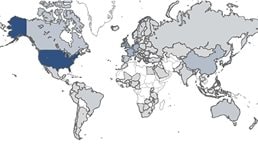As cross-border capital flows have declined in recent years, many banks have shifted their focus to recoup losses after the global financial crisis. In this episode of the McKinsey Podcast, McKinsey Global Institute partner Susan Lund and McKinsey senior partner Eckart Windhagen speak with MGI senior editor Janet Bush about how the shift to domestic lending and other financial activity has created a more stable financial environment overall and what challenges still remain.
Podcast transcript
Janet Bush: I’m Janet Bush. I’m a senior editor with the McKinsey Global Institute. Today, we’re going to talk about the findings of a new report from MGI on financial globalization—in other words, cross-border movements of foreign direct investment (FDI), equities, debt securities, and lending. With me today is Susan Lund, a partner with MGI in Washington, DC, and Eckart Windhagen, a McKinsey senior partner and also a member of the MGI Council, and he’s based in Frankfurt. Welcome to you both.
Eckart Windhagen: Hi, Janet.
Susan Lund: Hi.
Janet Bush: Susan, can I start with you? This is the latest in a series of MGI reports on financial globalization. What’s the current state of play?
Susan Lund: What we see is that, in the ten years since the global financial crisis began, cross-border capital flows have fallen by 65 percent, from over $12 trillion to just over $4 trillion in 2016. Half of that decline is coming from a decline in cross-border lending and other types of banking activity.
When we look at what’s happening with the global banks, we see that they are reducing their foreign exposure. They’re selling foreign businesses. They’re allowing loans to expire without renewing them, and they’re selling different types of foreign assets. Overall, there’s been a broad-based retreat toward more domestic activity.
The main drivers of this retrenchment have been, on one hand, the need to rebuild capital and recoup losses after the crisis, but, on the other hand, the need to meet international and new regulatory requirements at the local level. We also see that banks are just proceeding more thoughtfully as they consider their foreign business. They’re deciding to exit or reduce operations in markets where they lack scale or unique capabilities, and this is an ongoing process.
Janet Bush: Eckart, one of the features of this report is that the eurozone has played a central role in this retrenchment in flows. What’s the story there?
Eckart Windhagen: After the creation of the single currency, eurozone banks began expanding into other markets, in particular into European markets. With currency as well as country risk assumed to be zero, geography of assets and liabilities didn’t matter anymore. The stock of foreign bank loans and other claims quadrupled, from $4.3 trillion in 2000 to almost $16 trillion in 2007.
Want to subscribe to The McKinsey Podcast?
And now eurozone banks are at the epicenter of a retreat from foreign operations, so their total foreign loans and other claims are down by $7.3 trillion; that is 45 percent since 2007. Nearly half of that was intra-European borrowing, especially interbank lending.
In many ways, this is a rational response to massive, or one could even say excessive, expansion that was rather prevalent before the crisis. Risky lending and interbank lending being the most prominent part of that business.
At the same time, many eurozone banks are growing their domestic business. If we take the example of Germany, the largest banks in Germany decreased their foreign assets by more than half since 2007. At the same time, they increased their domestic business by 70 percent.
Retrenchment from foreign markets is not just a phenomenon of the eurozone, of course. Swiss, UK, [and other non-eurozone] banks, for example, have reduced their foreign loans and other claims by a combined $2.1 trillion, or 32 percent. US banks have also exited [foreign] markets.
Susan Lund: While you do see a major retrenchment of European and US banks, there are banks from other countries that are expanding abroad in different ways. For instance, Canadian banks are highly international, and they have increased their international businesses over the last ten years.
Right now, roughly half of the balance sheets of the large Canadian banks are overseas. That’s particularly visible in the US. We also see some of the largest Japanese banks expanding abroad in different ways. Partly, they’re active in the wholesale lending markets and syndicated lending in the US. But they’re also expanding in retail banking across Southeast Asia.
And probably the biggest change in the global landscape has been the increased activities of Chinese banks outside of China. We’ve seen that their foreign loans went from very low, almost negligible, levels ten years ago, to over $1 trillion at the end of 2016.
This reflects, in part, their following Chinese corporations as they invest abroad, in Africa, Latin America, the US, and Europe. Often, the financing for the foreign direct investment by Chinese companies is supplied by Chinese banks. So this is a major change, and we think, if anything, Chinese banks could continue to expand their foreign lending quite substantially.
Today, despite this tremendous growth, only 9 percent of their total assets are in foreign assets outside of China. When you look at banks in all the other advanced economies, at least 20 percent—and in many cases, a much larger share than that—is in foreign assets. If Chinese banks are to follow the examples of other banks in advanced economies, we could see their foreign assets double or even triple again in the years ahead.

Our interactive data visualization shows the size, growth, and structure of cross-border capital flows and the stock of foreign investment by country.
Janet Bush: Eckart, does the fact that so many large banks are retrenching mean, effectively, the end of financial globalization?
Eckart Windhagen: Absolutely not. Financial globalization is surprisingly robust. Financial markets remain deeply interconnected, but with a different profile. The global value of foreign investment as a percentage of GDP has been steady since 2007, at around 180 percent, and now stands as an absolute figure at more than $130 trillion.
Globally, 27 percent of equities are held by foreign investors. That’s up from 17 percent in 2000. And 31 percent of bonds are foreign-owned, up from 18 percent in 2000. Only lending has declined as a share of GDP, and we also see reasons to believe that the system is likely to be more stable than it was before the crisis.
In cross-border capital flows, there’s now less debt, which is intrinsically volatile. And there’s more foreign direct investment and equities, which are less volatile. Today, FDI and equities account for two-thirds of cross-border capital flows, compared with just one-third before 2007.
Another development that should make the system more stable, overall, is the fact that financial and capital account imbalances have dropped, from 2.6 percent of GDP in 2007 to 1 percent of GDP in 2016. And the US–China share is down by half.
Would you like to learn more about the McKinsey Global Institute?
Janet Bush: Thanks, Eckart. Susan, the report talks about new dynamics in financial globalization; potentially, more stability is one of them. Are there others?
Susan Lund: Yes, there are some other changes. First of all, we see that financial globalization is getting more inclusive, by which we mean that more countries are participating in global finance. We developed a new Financial Connectedness ranking in this report in which we list countries by the size of their total foreign-investment assets and liabilities.
What we see is that, first of all, financial globalization is heavily concentrated. So, advanced economies account for 85 percent of all foreign assets and liabilities. The top five advanced economies account for half of assets, and the top ten have 70 percent. This is still very much dominated by the largest countries in global finance, like the United States, UK, Germany, and so on. Against this backdrop, we also see that the share of foreign assets and liabilities of developing economies is rising. Ten years ago, their share was only 8 to 9 percent, and now it’s closer to 14 to 15 percent. So, it’s steady growth. As we mentioned earlier, China is a big part of this story. In our ranking, it rose from 16th in 2005 to 8th in 2016. China has undergone a notable shift as well in 2016. For the last decade or more, central-bank, foreign-reserve-asset purchases were the main capital outflow from China.
But in 2016, we saw that other types of private foreign assets—so foreign direct investment by companies, foreign bank lending, and purchases of portfolio equity and debt—surpassed the value of China’s foreign reserve assets for the first time. We think that trend will continue.
The second big change we see in financial globalization is the role of international financial centers. We found that there are ten heavyweight, international financial centers in our ranking. I should note there are many more countries that simply don’t report data—many of the small, island economies that are offshore financial centers. But of the ones that do report the data, we see that, between them, they account for about a quarter of global foreign investments and that one-third of the growth in global foreign investment over the last ten years has gone through financial centers. So they’re playing a larger role than they were before. Among these, to give some examples, would be countries like Luxembourg but also the Netherlands, Ireland, Singapore, Hong Kong, and a few others.
Janet Bush: Interesting. Eckart, can we assume that the instability of the past has been permanently squeezed out of the global financial system?
Eckart Windhagen: We clearly see the signs of more stability. But of course, there are still significant risks, and there is no room for complacency. Gross capital flows, particularly cross-border lending, remain volatile. In the past five years, more than 60 percent of developing countries, and over 70 percent of advanced economies, have had either a large decline or a surge or reversal or recovery in cross-border lending each year.
And the median size of these shifts is significant: 3 percent of GDP in developing economies and 7.7 percent of GDP in advanced economies. Among other risks, equity valuations have risen to new highs. Financial contagion remains a risk, despite the efforts of more rigorous regulation, and the rise of sometimes opaque, international financial centers still bears watching.
And there is new technology. It is too early to tell how new technology will play out. But it’s a new and significant dynamic factor, which enables faster, lower-cost, more efficient cross-border transactions. For instance, digital platforms, blockchain, machine learning, artificial intelligence—all of those are changing the dynamic and with very little deeper understanding of how this will unfold over time.
Janet Bush: What do banks need to do to adjust to this new era of global finance?
Eckart Windhagen: Global banks will need to shift their international strategies to focus on core markets and corporate clients. They need to transform risk management with advanced analytics, and they need to harness new technologies. Those players that won’t respond to those challenges, they will be left behind.
Regulators will need to continue refining bank regulation and systemic risk monitoring. They need to develop new tools to manage volatile capital flows—for instance, insurance funds, contingent debt contracts. And they need to enable fintechs to thrive but monitor new risks associated with advanced technology.
Our new global banking report, which we will publish soon, notes a significant change of underlying drivers for economic performance of banks. For the past decade, the question of where you place the geography in which you have your dominant footprint was always—by far—the most relevant aspect; two-thirds of factors accounted for geography. This is now down to one-third, while the performance of management teams has significantly grown in relevance.

The new dynamics of financial globalization
Janet Bush: Looking at this whole report, what did you find most surprising?
Eckart Windhagen: Clearly, the robustness of financial globalization, with a more healthy profile. Despite the almost crash of cross-border flow in the aftermath of the crisis, the global allocation of capital continued to evolve positively. A significant part of the cross-border flows at the peak was clearly decoupled from underlying, real-economy activities. And also, stabilization mechanisms and efforts, for example, by central banks, did work.
Susan Lund: I agree with Eckart that it was surprising to see how robust financial globalization has remained and the new ways that point to the fact that it may be more stable and resilient going forward. That’s all very good news that should be celebrated.
At the same time, I was struck by the changes in the banking industry, and particularly the largest banks. Globalization broadly has come under attack in many countries by both politicians and workers who have been displaced by trade. But when you look at industries and companies, you can’t find very many that are less globalized than they were before.
Over the past ten years, if anything, the world economy has continued to become more and more integrated. But that’s not true for the world’s largest banks from the US and Europe, at least. There you can find very large changes within individual banks that have made them far less global and more focused on domestic markets. That’s a pretty striking example that, in fact, globalization is not inevitable, and banking is one area where we can see a pretty dramatic reversal in how global they are versus how much they focus on domestic markets.
Janet Bush: Thanks, Susan, thanks, Eckart, very much. It was extremely interesting. For anybody who wants to read the report in full, go to www.McKinsey.com/mgi.
Eckart Windhagen: Thank you.
Susan Lund: Thank you, Janet.


